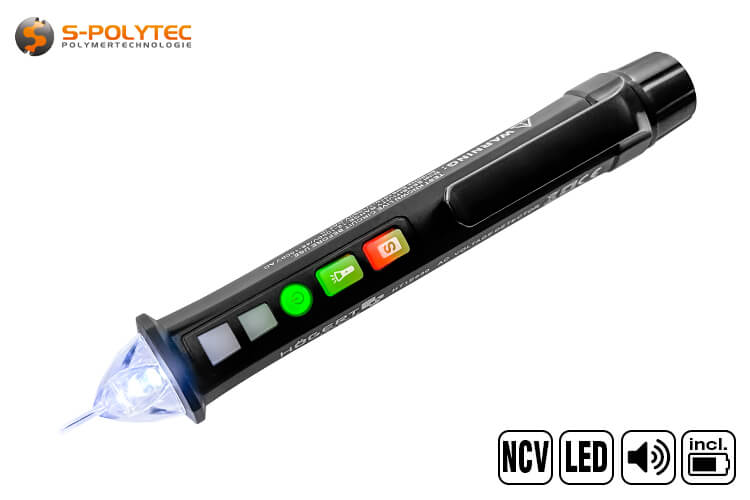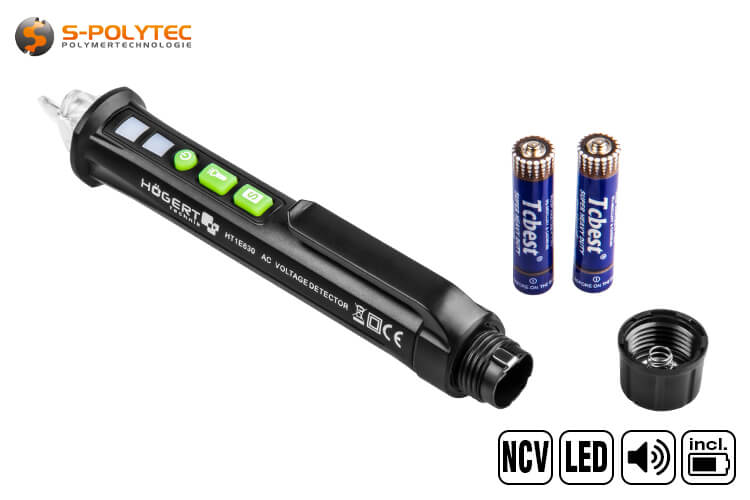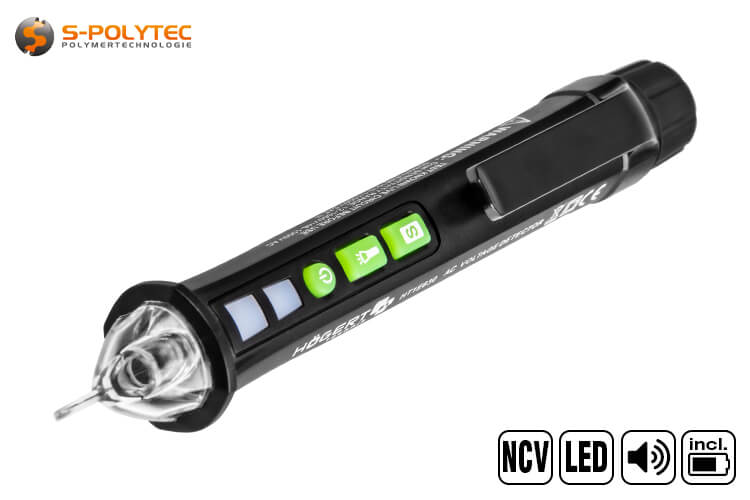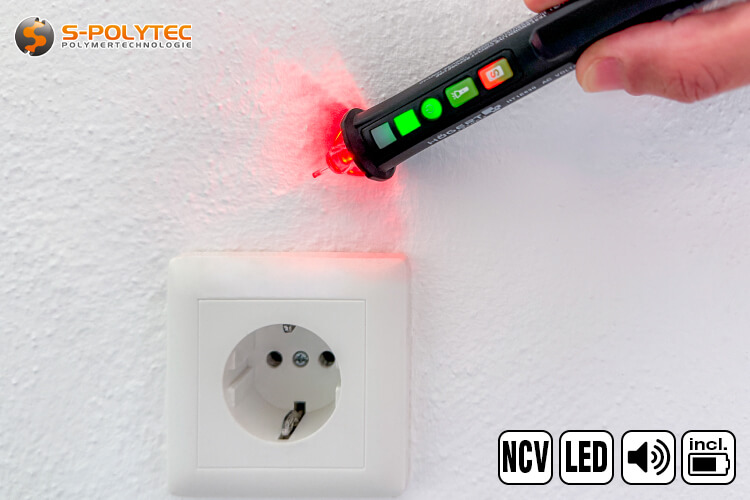
Inductive voltage tester
The inductive voltage tester from Högert enables contactless testing of live cables - even flush-mounted, thanks to adjustable sensitivity and is signalled both visually via a multi-coloured LED and acoustically.
✓ Switchable sensitivity
✓ For alternating voltage 12V/48V - 1000V
✓ Optical & acoustic signal
✓ Housing made of ABS plastic
✓ Integrated LED torch
✓ Compact design with clip
The voltage tester is powered by two standard AAA batteries, which are included in the scope of delivery.
The item is in stock
Dispatch within 2-3 working days
- calculate the price
€12.50 / pc.
0,0590 kg / pc.
All prices include 19% VAT.
- Description
Induction voltage tester - No more drilling into cables
Compact design ✓ Optical & acoustic signal ✓ For 12V/48V - 1000V AC ✓
With the inductive voltage tester from Högert, non-contact testing of live cables has never been easier. All you need to do is bring the professional measuring device with the NCV sensor close to the cable to detect whether the cable is live using an inductive method. Thanks to the adjustable sensitivity, this even works with cables laid under plaster or in drywalls. This is signalled both visually and acoustically. The colour of the signal LED, as well as the speed of the signal tone, varies in three stages depending on the intensity of the signal, which increases the closer you get to the power source. The tester also enables a continuity test to be carried out and the location of the current interruption to be determined in the event of damaged cables.
Our cable tester is very easy to use and can be operated at the touch of a button. Another button increases the sensitivity of the induction sensor and the third button switches on an LED light. The visual signalling in traffic light colours also requires little explanation, making a glance at the operating instructions supplied obsolete. As a measuring device for industry and trade, it is also approved for commercial use and on construction sites.
Features of the NCV voltage detector from Högert
The high-quality voltage tester is intended for professional use by craftsmen and DIY enthusiasts. The high-quality standards associated with this are important and can only be met by using high-quality materials and smooth operation. The compact housing is made of black ABS plastic, which is characterised by its high impact resistance. The voltage tester can therefore easily withstand knocks or drops, even if it falls out of your hand. The front is made of transparent plastic and completely encases the induction sensor. This is also where the LEDs for the signal light are located, which lights up in intense red when an AC voltage is detected, as well as the LED for the integrated torch. The screw-on cover for the battery compartment, which contains the two batteries supplied, is located on the back. Further LEDs are located on the top of the device, which indicate the intensity of the detected signal. The rubberised buttons for switching the device on and off and for activating and deactivating the torch are also located there. The third button, which is labelled with an S symbol, is used to increase the sensor sensitivity. If this is active, the button lights up red. The belt clip, which is also located on the top, is used for practical storage on the belt or in a breast pocket so that the voltage tester is always quickly to hand when a measurement needs to be carried out. To maximise the service life of the batteries, the inductive voltage tester has an automatic switch-off function. This means that the device switches off after around 5 minutes, but can be switched on again very easily if the measurements have not yet been completed.
The function of the measuring device is explained simply. After switching on, the measuring device is brought close to the cable to be tested. The plastic-coated induction sensor detects inductances that occur when current flows through a cable. These can be more or less strong depending on the voltage and are indicated by different visual and acoustic signals. Cables that are laid in the wall or floor also have a reduced signal, so that the input sensitivity of the sensor can be reduced from 48 volts to 12 volts. In this way, it is also possible to locate concealed cables. This is a decisive advantage for installation work of all kinds, which is why the voltage tester is a much sought-after tool for tradespeople, from kitchen fitters and façade builders to patio roof installers, as it contributes to the safety of employees and minimises the risk of high costs for repairing a drilled cable.
A useful little gimmick is the switchable torch, which makes it possible to locate the faulty area in the cable that is responsible for the ceiling light not working, even in poorly lit rooms or in complete darkness. Much more important than the torch, however, is that the voltage tester also complies with the necessary handling and safety standards. Compliance with the safety classes CE CAT.III 1000V / CAT.IV 6000V are the CE markings that are important. However, the CE mark is mandatory for all appliances sold in the EU anyway, so it doesn't really need any special mention. Much more important here are specific EN and DIN standards, which vary greatly depending on the product. For example, DIN61010-1 applies to electrical measuring devices. The fact that all requirements of the standard are met, which is also confirmed by a white label on the side of the housing, means that the voltage tester is also approved for commercial use by industry and trade. This makes our tester a very useful and, for many tradespeople, indispensable tool for ensuring personal safety and preventing damage to power lines.
Advantages of the Högert voltage detector for AC voltage
- The inductive NCV sensor enables contactless detection of live cables
- The voltage detection signal is given both visually and acoustically
- Also suitable for live cables in walls thanks to adjustable sensitivity
- The signal display indicates the intensity of the signal in three different colours
- The compact housing made of impact-resistant ABS plastic protects against mechanical damage
- The buttons on the top allow one-handed operation with the left or right hand
- The integrated torch also allows you to work in poor lighting conditions
- The battery life is extended by the automatic switch-off function
Application and handling of the inductive voltage detector
The batteries must be inserted into the housing before initial commissioning. These are included in the scope of delivery. To insert the batteries, the housing must be unscrewed at the back and the batteries inserted one after the other with the positive pole first. For safety reasons, this is also engraved on the underside of the housing. Finally, the battery cover can be screwed back on so that the circuit is closed and the power supply to the measuring device is guaranteed. The voltage tester is switched on by pressing the round on/off button. All of the device's LEDs light up for a brief moment and a simple, short signal tone sounds. Changing the batteries works in the same way and is signalled by a flashing status LED when switching on, as well as by an acoustic signal when a battery change is required.
Safety first
Before using the voltage tester, it is essential to check whether the battery voltage is still sufficient, as there is nothing worse than drilling into a cable or even hammering it with a nail and getting an electric shock because you have relied on the fact that there is no power cable nearby because the device has not displayed anything. All you need to do to test it is switch it on and bring it close to a cable. This can be near a socket but could just as easily be the connecting cable of a floor lamp. It is important that these must also be live and that the fuse is switched on. Only after this function test can you be sure that the device is working reliably and can be used without hesitation.Find cables at the touch of a button
The voltage tester is used to check whether a line is live or to locate a line in the wall. However, this only works for circuits with alternating voltage, as is usual for the mains power supply of lamps, sockets, appliances, machines and systems. To do this, switch on the device, carry out a function test to be on the safe side and point the sensor in the direction of the cable to be tested. If the voltage tester detects the presence of voltage, this is indicated both acoustically and by the LED on the head lighting up, as well as via the signalling diode in front of the on/off switch. The stronger the voltage, the higher the inductive voltage that can be detected by the sensor. This is signalled in three different colour gradations. If the signal LED above the on/off button lights up red continuously, this indicates a high signal, i.e. a high voltage or a live wire in the immediate vicinity. If, on the other hand, the diode lights up green continuously, the signal is either slightly distant or the voltage is moderate. If the LED flashes green, on the other hand, this indicates a weak signal. This means that although there is a cable nearby, it should still be far enough away to drill a hole in the wall. The acoustic signal also changes with the speed of the beep tone, which sounds in increasing succession as the signal strength increases.TIP: Pressing the system button S increases the signal sensitivity so that live cables in walls, ceilings and floors that are flush-mounted can also be detected. The higher input sensitivity of the NCV sensor is indicated by the red LED lighting up in the front area of the system button.
On the safe side even in the dark
With the integrated torch, locating and checking live cables in dark cellar rooms or in poor lighting conditions is no longer a problem and therefore reduces the risk of accidents while you are searching for the cable. Although the light cannot keep up with a real torch, it is sufficient to illuminate the surroundings enough to recognise tripping hazards caused by objects on the floor or mounted on the wall or ceiling. The white LED on the front of the voltage detector can be switched on by simply pressing the green button, which is labelled with a torch symbol. A further press switches the lamp off again. To prevent the torch from accidentally remaining switched on, which would unnecessarily shorten the battery life, an automatic switch-off function ensures that the torch is deactivated after 5 minutes.Technical data of the Högert voltage tester
- Product type: Electrical measuring device
- Material (housing): ABS plastic
- Dimensions: 156mm x Ø20mm
- Suitability for trade fairs: Alternating voltage
- Voltage range: 12V/48V - 1000V AC
- Frequency: 50Hz / 60Hz
- Measuring method: Induction
- Measurement result: Visual and optical signal
- Safety class: CE KAT.III 1000V / CE KAT.IV 600V
- Battery level indicator: Yes (status LED)
- Operating voltage: 3V (2 x 1.5V AAA battery included)
- DIN standard: DIN EN 61010-1
- Commercial use: Permitted
Storage and care of the line detector
There is not much to consider when storing and caring for the voltage tester. Thanks to the robust ABS housing, the measuring device can withstand even slight knocks during transport in the tool case without its function suffering as a result. If the housing, especially the transparent tip with the NCV sensor, is dirty, this can affect the measurements. It is therefore recommended to clean the tester occasionally and wipe it with a damp cloth.
If the voltage detector is not used for a longer period of time, as well as in cold or damp environments, the batteries should be removed from the device to prevent premature discharge due to cold and battery corrosion due to discharge inside the device.
Information on batteries and used batteries
WARNING: Empty batteries must not be disposed of with household waste and must be disposed of properly in suitable collection containers.
The batteries included in the scope of delivery are not rechargeable and must be disposed of properly after discharge to protect the environment. As the distributor, we at S-Polytec are obliged under the EU Battery Ordinance (EU-BattV 2023/1542) to inform you that the batteries are non-rechargeable general purpose device batteries, which you can either dispose of free of charge at voluntary collection points or return to us for proper disposal.
- Additional Information
Additional Information
Product-ID LPR01 Delivery Time Dispatch within 2-3 working days EAN/GTIN 5902801296802 Material Housing made of ABS plastic Property NCV sensor (battery-operated, 2x AAA ) Weight 0.0590 - Reviews







